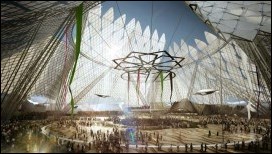by Brianna Crandall — January 22, 2014—Facilities managers who deal with the preparation and management of outdoor events and structures may appreciate some sustainable best practices gleaned from global design, architecture, engineering and planning firm HOK’s design of the 2020 World Expo in Dubai, which HOK intends to be a new sustainable benchmark for events in the Middle East and similar regions. The Expo is considered the third-largest global event after the Olympics and the FIFA World Cup.
Dubai was recently chosen as the site of the 2020 World Expo, themed “Connecting Minds, Creating the Future,” which is expected to draw more than 25 million visitors from October 2020 through April 2021. Dubai’s selection by the Bureau of International Expositions’ (BIE) 168 member nations over three contender cities in Brazil, Russia and Turkey marks the first time ever for a Middle Eastern city to host the event in its 150-year history.
HOK led the design team that developed the master plan for the Expo, which is intended to reflect “the wonderful qualities of Dubai and the form and spirit of a World Expo,” and to look to the future while drawing on traditional Emirati community planning concepts. Populous provided venue planning and participant design guidelines, and Arup provided infrastructure and transportation services. The 1,082-acre (438-hectare) Expo site is on the southwestern edge of Dubai in Jebel Ali, near Dubai’s new Al Maktoum International Airport and Jebel Ali Port.
HOK’s design features three separate pavilions symbolizing opportunity, sustainability and mobility, with “innovation pods” and “best practice areas” in each thematic zone. These three zones emanate from a central plaza named the Al Wasl, a historical name for Dubai meaning “the connection.” Inspired by the layout of a traditional Arabic “souk,” or marketplace, the design places larger pavilions to the perimeter while clustering smaller exhibit spaces toward the center of the site. This creates a smooth pedestrian flow while encouraging interaction among visitors.

Sustainable features
The team planned the Expo site and infrastructure to create a new sustainable benchmark for events in the Middle East and similar regions. A photovoltaic fabric structure covers the main walkways, acting as a solar-powered sun shade and combining with PV panels on building façades to capture enough sunlight to generate at least half of the Expo’s energy requirements onsite. At night, the fabric will be transformed into an illuminated display of lights and digital projections. Smaller connective streets will be shaded through the use of pavilions and strategic landscaping.
The alternative transportation plan includes a gondola that links each of the thematic zones and the main entrance while creating an additional viewing experience for visitors. Other sustainable strategies include recycling wastewater, reusing materials and monitoring the carbon footprint. After the close of the Expo in 2021, three main pavilions—the Welcome Pavilion, the Innovation Pavilion and the UAE Pavilion—will be combined and transformed into the Museum of the Future.





